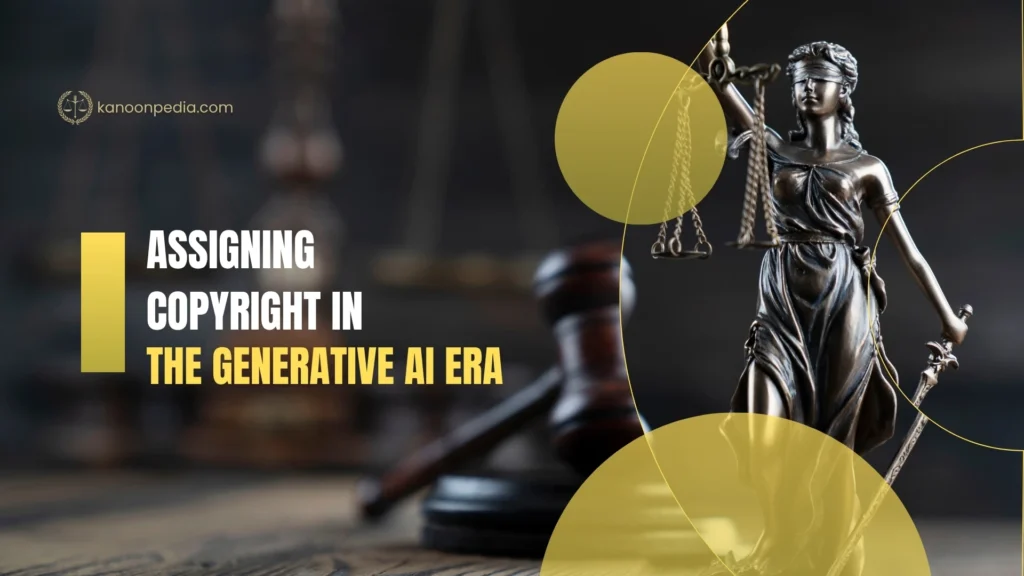In the rapidly evolving landscape of generative AI, Assigning Copyright in the Generative AI Era hinges on centering human creativity as the touchstone of copyright protection. Practitioners should structure workflows and agreements so that the human user who provides the creative spark and refines AI outputs holds the copyright—ensuring clear incentives for innovation and compliance with established law.

Table of Contents
Understanding “Assigning Copyright in the Generative AI Era”
Generative AI—systems capable of producing text, images, music, and more from user prompts—poses profound questions for copyright law. Central to Assigning Copyright in the Generative AI Era is the requirement that only human-authored expression may be protected under extant frameworks. The U.S. Copyright Office (USCO) Part 2 Report confirms that outputs of generative AI lack independent copyright unless a human contributes sufficient creative expression. Consequently, the most pragmatic allocation of rights vests in the user who crafts prompts, selects outputs, and performs substantial edits.
Human Authorship as the Bedrock
Copyright law across common-law jurisdictions has long required a “modicum of creativity” supplied by a human author. Courts have consistently:
- Refused registration for works generated entirely by machines (e.g., monkey selfies, Pollock-style splatters).
- Denied copyright to images or text produced without human intervention, holding them in the public domain.
In Assigning Copyright in the Generative AI Era, this doctrine prevails: a prompt alone does not equate to authorship, because AI’s algorithmic processes shape the final expression beyond the user’s direct control. Only when a human’s creative decisions are “perceptible” in the result does copyright attach.
Legal Precedents and Policy Developments
U.S. Copyright Office Guidance
On January 29, 2025, the USCO issued Part 2 of its AI report, clarifying that:
- Fully AI-generated works lack copyrightability absent human authorship.
- Prompt engineering—even if intricate—fails to meet the originality threshold.
- Case-by-case analysis judges whether human edits, selections, or arrangements suffice to confer authorship.
This affirms that Assigning Copyright in the Generative AI Era requires evidence of human creative control—such as refining AI drafts, curating outputs, or transforming AI material into a cohesive work.
Court Decisions on AI-Assisted Works
Several judgments reinforce this approach:
- Design Data v. Unigate (2017): CAD-generated drawings bore no derivative rights of the software developer.
- Rearden v. Walt Disney (2018): CGI wireframes did not subsume the film’s human artistry.
- Cummins v. Bond (1927) & Penguin Books v. New Christian Church (2000): Spiritual or purportedly divine communications were deemed the human intermediary’s work, not that of spirits.
These cases illustrate that courts look for human decision-making and editorial involvement—key to Assigning Copyright in the Generative AI Era.
Practical Framework: Vesting Rights in the Human User
To operationalize Assigning Copyright in the Generative AI Era, organizations and creators should:
- Define Roles in Agreements
- Specify that the human user (or commissioning entity) holds copyright in final deliverables.
- Require assignment of rights from developers or platforms to end users.
- Document Creative Contributions
- Maintain records of prompt iterations, selection processes, and post-generation edits.
- Use version control to demonstrate human modification.
- Incorporate AI in Work-Made-for-Hire Structures
- Treat AI-assisted tasks as outsourced components under work-made-for-hire.
- Vest authorship and ownership explicitly in the hiring party.
- Use Clear Licensing
- Negotiate licenses for AI models that confirm end-user ownership of outputs.
- Avoid ambiguous terms that reserve rights for AI developers.
By adopting these measures, stakeholders can ensure that Assigning Copyright in the Generative AI Era remains consistent with both legal precedent and commercial incentives.
Comparative International Perspectives
While the U.S. remains cautious about AI authorship, other jurisdictions offer contrasting approaches:
These variations highlight that Assigning Copyright in the Generative AI Era may evolve differently worldwide, but human creative input remains the universal touchstone.
Keyword Implementation
Throughout this guide, Assigning Copyright in the Generative AI Era has been emphasized to underscore its centrality. By reiterating Assigning Copyright in the Generative AI Era, we reinforce its significance as the guiding principle for rights allocation in the era of algorithmic creation. Readers are encouraged to integrate Assigning Copyright in the Generative AI Era into policy, drafting, and licensing frameworks, thereby ensuring a solid foundation for protecting human-driven innovation.
Frequently Asked Questions
1. What level of human involvement suffices for copyright?
A human must contribute u003cstrongu003eoriginal expressionu003c/strongu003e—such as editing, arranging, or combining AI outputs with pre-existing content—in a way that is perceptible in the final worku003ca href=u0022https://newsroom.loc.gov/news/copyright-office-releases-part-2-of-artificial-intelligence-report/s/f3959c36-d616-498d-b8f9-67641fd18babu0022 target=u0022_blanku0022 rel=u0022noreferrer noopeneru0022u003eu003c/au003e.
2. Does prompt engineering alone confer authorship?
No. Detailed prompts are considered instructions, not expressive works, and fail to meet the originality threshold without further human modificationu003ca href=u0022https://www.manatt.com/insights/newsletters/copyright-office-releases-new-report-on-copyrightability-of-ai-worksu0022 target=u0022_blanku0022 rel=u0022noreferrer noopeneru0022u003eu003c/au003e.
3. Who should own the copyright in AI-assisted works?
Best practice is to vest rights in the u003cstrongu003ehuman useru003c/strongu003e or commissioning party, who integrates AI outputs into a creative whole and bears commercialization risks.
4. Can an AI developer claim authorship?
Generally not. Developers hold rights in the software, but courts and the USCO have rejected attributing authorship of specific outputs to them absent significant human interventionu003ca href=u0022https://www.dlapiper.com/en/insights/publications/2025/02/ai-and-authorship-navigating-copyright-in-the-age-of-generative-aiu0022 target=u0022_blanku0022 rel=u0022noreferrer noopeneru0022u003eu003c/au003e.
5. Should new legislation recognize AI as author?
The USCO concluded that existing law suffices for case-by-case determinations, obviating the immediate need for sui generis AI-author statutesu003ca href=u0022https://newsroom.loc.gov/news/copyright-office-releases-part-2-of-artificial-intelligence-report/s/f3959c36-d616-498d-b8f9-67641fd18babu0022 target=u0022_blanku0022 rel=u0022noreferrer noopeneru0022u003eu003c/au003e.
Conclusion:
Assigning Copyright in the Generative AI Era demands anchoring protection in human creativity. By structuring transactions, documenting contributions, and clearly assigning ownership to users, stakeholders can navigate the generative AI frontier with confidence—ensuring that the spark of human ingenuity continues to drive innovation and receive rightful legal recognition. Discover How to Become an Intellectual Property Lawyer in India and What Skills Are Needed?